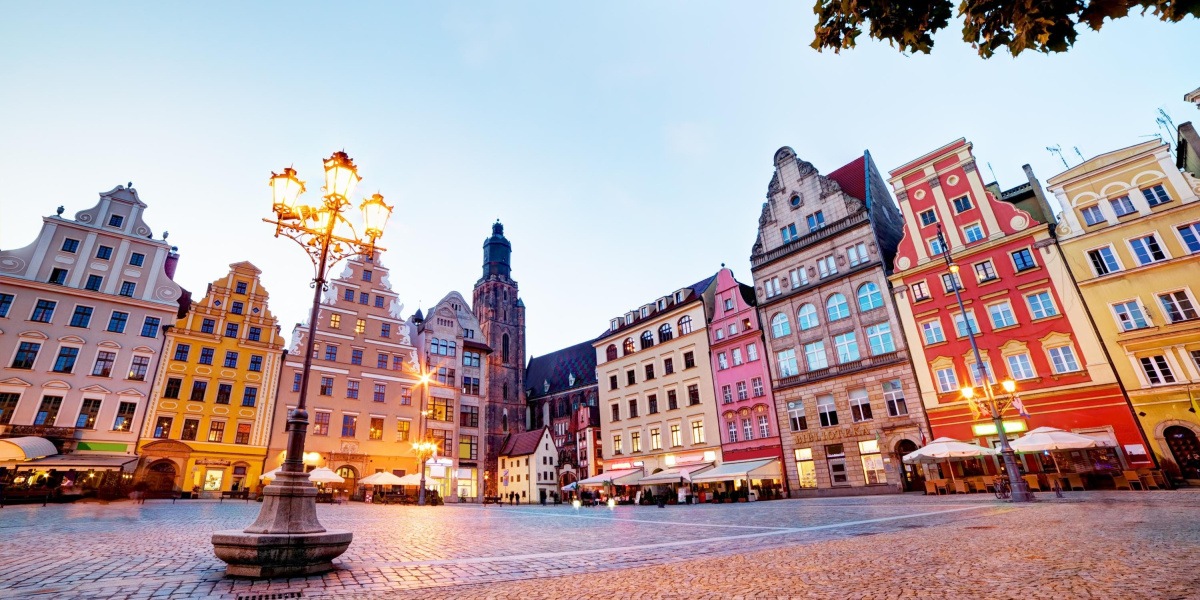Wroclaw

Known for its charming Market Square lined by colorful townhouses, Wroclaw is the fourth-largest city in Poland. It is a lively cultural center with a large student population, and it offers theaters, nightlife and interesting history for travelers to discover. The most popular attractions include the Gothic Old Town Hall with its astronomical clock, and the Panorama of Racławice - a 15×114 meter painting of the Battle of Racławice. Wroclaw is an idyllic city, located by the Odra River in western Poland, drawing in a growing amount of tourists.
Wrocław is a major attraction for both domestic and international tourists. Noteworthy landmarks include the Multimedia Fountain, Szczytnicki Park with its Japanese Garden, miniature park and dinosaur park, the Botanical Garden founded in 1811, Poland's largest railway model Kolejkowo, Hydropolis Centre for Ecological Education, University of Wrocław with Mathematical Tower, Church of the Name of Jesus, Wrocław water tower, the Royal Palace, ropes course on the Opatowicka Island, White Stork Synagogue, the Old Jewish Cemetery and the Cemetery of Italian Soldiers. An interesting way to explore the city is seeking out Wrocław's dwarfs – over 800 small bronze figurines can be found across the city, on pavements, walls and lampposts. They first appeared in 2005.
The Racławice Panorama is a monumental cycloramic painting, done by Jan Styka and Wojciech Kossak, depicting the Battle of Racławice during the Kościuszko Uprising in 1794. The 15×114 meter panorama was originally located in Lwów and following the end of World War II it was brought to Wrocław.
Wrocław Zoo is home to the Africarium – the only space devoted solely to exhibiting the fauna of Africa with an oceanarium. It is the oldest zoological garden in Poland established in 1865. It is also the third-largest zoo in the world in terms of the number of animal species on display.
Small passenger vessels on the Oder offer river tours, as do historic trams or the converted open-topped historic buses Jelcz 043. In 2021, the Odra Centrum has opened, an educational centre on the river which is offering workshops, a library and kayak rentals.
The Centennial Hall (Hala Stulecia, German: Jahrhunderthalle), designed by Max Berg in 1911–1913, is a World Heritage Site listed by UNESCO in 2006.
Wrocław is home to the Audiovisual Technology centre (formerly Wytwórnia Filmów Fabularnych), the Film Stuntman School, ATM Grupa, Grupa 13, and Tako Media.
Film directors Andrzej Wajda, Krzysztof Kieślowski, Sylwester Chęciński, among others, made their film debuts in Wrocław. Numerous movies shot around the city include Ashes and Diamonds, The Saragossa Manuscript, Sami swoi, Lalka, A Lonely Woman, Character, Aimée & Jaguar, Avalon, A Woman in Berlin, Suicide Room, The Winner, 80 Million, Run Boy Run, Bridge of Spies and Breaking the Limits.
Numerous Polish TV-series were also shot in Wrocław, notably Świat według Kiepskich, Pierwsza miłość, Belfer, and Four Tank-Men and a Dog.
There are several theatres and theatre groups, including Polish Theatre (Teatr Polski) with three stages, and Contemporary Theatre (Wrocławski Teatr Współczesny). The International Theatre Festival Dialog-Wrocław is held every two years.
Wrocław's opera traditions are dating back to the first half of the seventeenth century and sustained by the Wrocław Opera, built between 1839 and 1841. Wrocław Philharmonic, established in 1954 by Wojciech Dzieduszycki is also important for music lovers. The National Forum of Music was opened in 2015 and is a famous landmark, designed by the Polish architectural firm, Kurylowicz & Associates.

